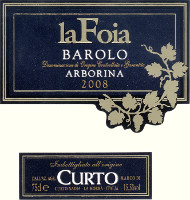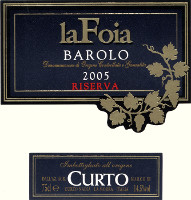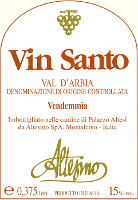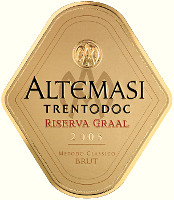|
The temperature at which a wine is served represents a critical element for the
correct perception and development of its organoleptic characteristics. The
right temperature of service can in fact improve the pleasingness of a wine as
well as drastically change its real nature. For this reason, temperature is the
best friend of any sommelier, whom - in order to ensure the best possible
condition of tasting - use it according to the sensorial qualities of wine to
be attenuated or emphasized. In other words, the accurate choice of the
temperature of service can be proficiently used to hide certain faults
as well as emphasizing specific qualities. A mediocre wine, therefore, can
taste better than what it really is; likewise, an excellent wine can be
worsened when served to the wrong temperature.
It must however be said temperature is not capable of making astonishing
sensorial miracles: a bad quality wine can be slightly improved according to the
temperature at which it is being tasted, it will however keep its real quality.
The temperature at which a beverage or food is tasted has the property of
changing the sensorial perception, including tactile stimuli. A food or beverage
tasted at different temperatures will have, not only different tastes and
aromas, but also different tactile profiles, by drastically affecting its
organoleptic perception. For example, we could consider the difference in
tasting a cold beverage - even the simple water will do - with the very
same beverage tasted at a quite higher temperature. Its sensorial profile, as
well as the psychological approach towards the beverage, will be different.
It could be considered, for example, the tasting of a cold beverage in summer:
psychologically speaking, the low temperature anticipates the pleasure it can
give in terms of wellness to contrast the hot temperature. The same
beverage, served cold in winter, will give a completely different psychological
effect, by wishing a higher temperature or even hot. The pleasingness of a
beverage - and wine, of course, is no exception - is strongly determined by the
temperature of service which can be properly used according to room temperature
and season in order to improve its enjoyability. Not only from a tactile point
of view - a very important sensorial characteristic - but also, and in
particular, for the improvement of the perception of aromas, flavors and tastes.
The effects of temperature on the sensorial perception of a food or beverage
are - or, better said, should be - well known to wine tasters. Every taster
knows that tasting a wine at a wrong temperature can significantly
affect the reliability of his or her job. Like already said in the past, wine
quality is expressed in function of the absence of faults, or - at least - to
their minimum possible presence and minimum impact. The temperature at which a
wine is tasted can in fact hide the presence of faults or, better said,
strongly attenuates their perception. This is true both for the perception or
wine aromas as well as for its taste. Tasting a wine at a very low temperature,
means strongly flattening its sensorial profile, as well as
significantly attenuating the impact and the intensity of any possible fault.
|
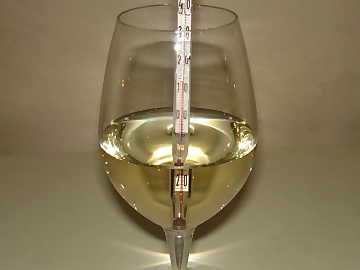 | |
| Sensorial tasting of white wines is
done at a temperature higher than the one used in service | |
|
As for the temperature of tasting - that is the critical and analytic operation
having the goal of determining the quality and characteristics of a wine - it
follows principles different from the ones used for service. The temperature of
service, that is the one used for the best expression of a wine's pleasingness
and used in ordinary consumption, it is in fact based on rules allowing
the reaching of this goal. In the ordinary service of wine, temperature is used
in order to emphasize certain wine qualities and the attenuation of any possible
fault. On the other hand, in sensorial tasting the goal is to favor conditions
such to proficiently perceive any possible presence of faults and, therefore,
the temperature is determined according different criteria. On this context,
therefore, it is favored the expression of faults.
Among the worst pitfalls of sensorial tasting there is low temperature. If it is
true - we will see later - a high temperature can favor and emphasize the
perception of certain wine qualities, also negative ones, low temperature has
the property of attenuating most of the stimuli. For this reason, in choosing
the temperature of sensorial tasting of wines, it is usually favored a
temperature slightly higher than the common ones and used for the service
of wine. The reason is essentially associated to the best development of the
organoleptic sensations - good and bad ones - although this could also favor the
excessive development of the ones sensitive to heat. It is - in any case - an
acceptable compromise in order to favor the perception of the worst enemies of
quality: faults.
Let's understand the effects of temperature on the many sensorial aspects during
the evaluation of a wine. The only sensorial characteristic not affected by
temperature is appearance. If it is true temperature however affects the
appearance of wine, this effect is the result of a slow process taking place
within months or years. In the evaluation of appearance during sensorial
tasting, temperature is therefore a negligible factor as the change to which the
wine is subjected is very short. We will see later, temperature has evident
effects both on the development of aromas as well as of taste, even completely
changing - with an excessively wrong use - the profile of a wine.
In the olfactory evaluation of a wine, the first aspect to be analyzed - always
- is the presence of faults, sometimes being evident and macroscopic,
sometimes light and weak, as to be completely ignored by a
careless nose. As for the development and the perception of aromas, temperature
plays a fundamental role and according to the volatility of odorous substances.
As the temperature goes down, the perception of aromas will be attenuated and
completely disappear, whereas high temperatures favor their development,
including the violent ethereal character of ethyl alcohol. Temperatures lower
than 5 °C (40 °F) will significantly attenuate the development of any aroma,
whereas the ones higher than 20 °C (68 °F) will excessively emphasize the
ethereal character of alcohol, while making all the other aromas smell as
rough.
On this regard, it can be done a simple experiment. Let's take a wine and pour
the same quantity in two tasting glasses, then let's seal both with a
cellophane film. One glass will be kept in the freezer of your fridge, whereas
the other will be left at room temperature. After one hour, remove the
cellophane film from both glasses and smell the two wines: the cold one will be
almost mute and with no aromas, whereas the other one will develop more
intense aromas and it will be possible to smell - in particular in summer - the
ethereal and volatile character of ethyl alcohol. Another experiment which can
be done is about a wine having an evident fault, such as - for example - the
infamous cork taint. After having cooled down the wine in a freezer for
one hour, the disgusting fault will seem to be disappeared, more precisely, its
perception will be strongly attenuated. The same wine, as the temperature goes
up, will seem to accentuate this unpleasing smell.
Temperature substantially affects the perception of taste and of tactile
stimuli of a wine. The sensations generally defined as round -
sweetness, the impact of alcohol and roundness - are emphasized with high
temperatures and, on the other hand, are attenuated by low ones. Some gustatory
sensations defined as hard, have an opposite behavior, in particular
astringency and the perception of bitter flavor. On this regard, we should
notice the sensation produced by astringency is to be considered as a tactile
stimulus, produced by the interaction of tannins with the mucosa of oral cavity
and, in particular, with its property of bonding with proteins. Astringency in
wine also produces a bitter flavor, which nature and intensity depend on the
type of polyphenols found in a wine and on their ripeness at the moment
of tasting.
Astringency increases the intensity of its tactile stimulus as the temperature
goes down, whereas tends to get rounder as the temperature goes up. The
perception of bitter flavor follows - in general terms - the same type of
pattern: a low temperature accentuates its perception. On this regard it should
be said the perception of a bitter flavor is also in function of round
substances found in wine that, in this case, work a contrasting action. The
perception of round substances - including sugar - is stronger as the
temperature goes up, therefore, in this case, the contrasting action to the
bitter flavor will be more effective. Carbon dioxide - responsible of
effervescence in sparkling wines - changes its development according to
temperature. Low temperatures significantly slow its release, therefore
prolonging the show of bubbles in the glass.
According to an organoleptic point of view, carbon dioxide has a basically
acidic taste, a gustatory sensation which perception remains unaltered with
temperature changes. Acidity is well perceptible at any temperature, we should
however notice its pleasingness is better at low temperatures. In sensorial
tasting, white wines are usually evaluated at a temperature of 12-14 °C
(52-57 °F) and according to their evolution, whereas reds are evaluated at a
temperature of about 18 °C (64 °F). Sparkling wines are never evaluated at the
canonical temperature of 8-10 °C (46-50 °F) because the perception of
aromas and faults would be attenuated, therefore it is used a higher
temperature instead. In any case, the temperature for tasting wines is never
higher than 20 °C (68 °F), as this temperature would make alcohol volatility
too aggressive and the finesse of aromas would be compromised. In sensorial
tasting, it should be noticed the main goal is the evaluation of wine quality
and the correspondence to its type. Temperature is one of the factors favoring
- when correctly used - the conditions for a better analysis and, as such, it
must be determined according to the type of wine.
|


